Titles are among the most important things in SEO. But, although it is very basic to have your keywords inside the title, it isn’t always easy to write SEO friendly title tags. That’s why we’ve prepared this guide and set of best practices you need to follow in order to have well optimized titles on all of your website’s pages.
If there’s one thing I’ve noticed during many years of practicing SEO, it’s that people heavily neglect titles. Countless times have I been told – “I’ve worked with an SEO agency before, but with no results” – just to see that the “agency” hasn’t even optimized something as basic as the title tag.
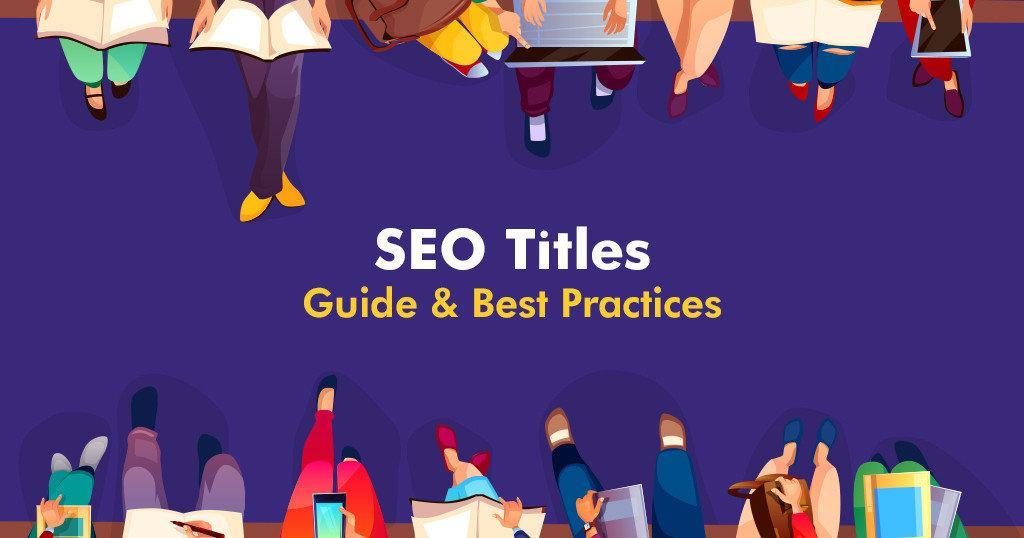
- What Are Page Title Tags?
- Why Are Title Tags Important for SEO?
- What’s the Difference Between H1 Tags and Title Tags?
- SEO Title Tags Tips & Best Practices
- Write the title for humans first
- Keep your titles short and to the point
- Try adding the main keyword closer to the beginning
- If possible, try optimizing the title for multiple keywords
- Try to avoid keyword cannibalization with other articles
- Make your title catchy to improve CTR
- Fill short titles with calls to action
- Make your article & title look fresh
- Back up your title tag with relevant content
- Use different titles for SEO & Social Media
- How to Craft an SEO Friendly Title Tag
- How To Write Bulk (Auto-generated) Title Tags for eCommerce Websites
- Why Is Google Showing a Different/Wrong Title Tag?
What Are Page Title Tags?
You might think that the title tag is the phrase you write in WordPress or whatever platform you use and which represents the title of your page/article. However…
The title tag is actually an HTML element which serves a number of key roles in browsers, search engines and on the web, in general.
Like any other HTML tag, the title meta tag is surrounded by angle brackets and it has a start tag <title> and an end tag </title>. The actual title is found between those tags.
The title of this particular article you’re reading right now is written as follows:
<title>How to Write SEO Friendly Title Tags | Guide & Best Practices</title>
If you hit CTRL + U on your Windows machine (I don’t know the combination for Mac OS Safari) or right click anywhere on the article and hit View Source, you will be able to spot the title tag in its true form.
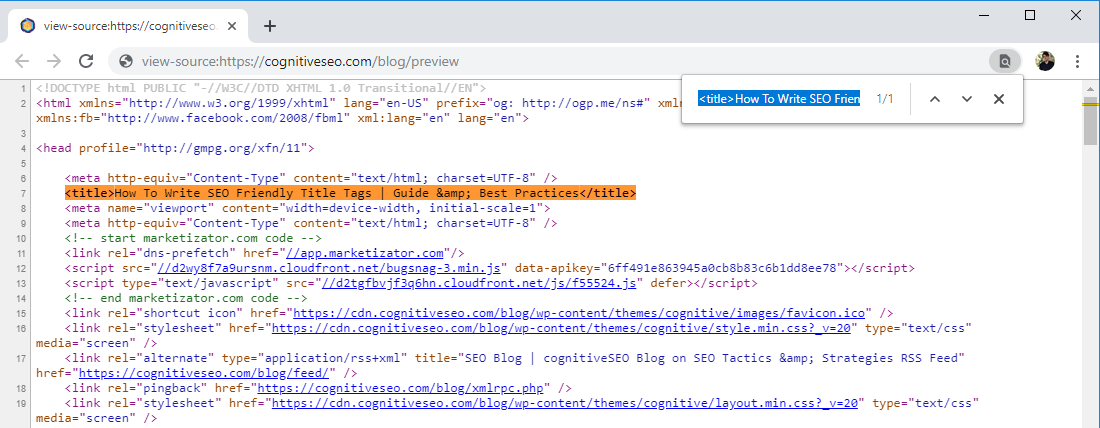
If you can’t see it, use CTRL + F to search for the start tag <title>.
The title tag’s contents are also displayed inside the browser tabs. You can hover over them to view the full title of a web page.

However, titles aren’t there just to look pretty. They serve a purpose, especially for search engines and SEO.
Why Are Title Tags Important for SEO?
The title tags are considered to be an important SEO ranking factor. There are multiple reasons why titles are important for SEO. The first one would be that it’s the main thing users see when they search something on Google or any other search engine.
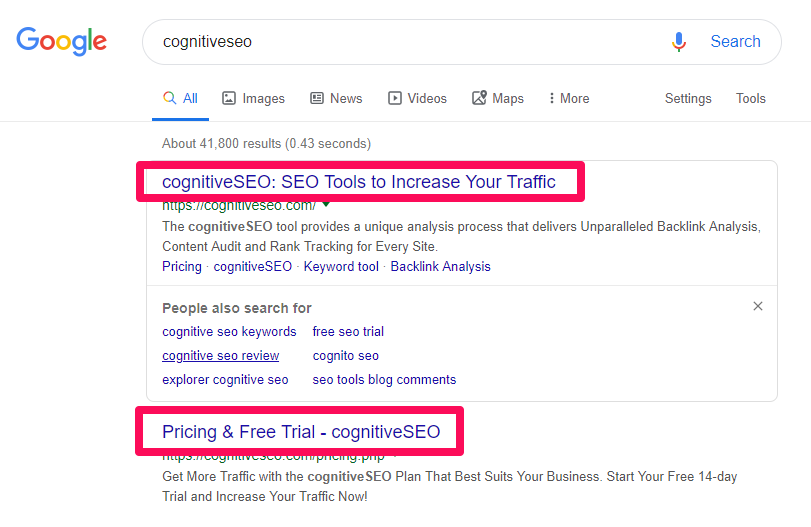
Unless specified otherwise, the title meta tag will also be used on most social media platforms when sharing a link.
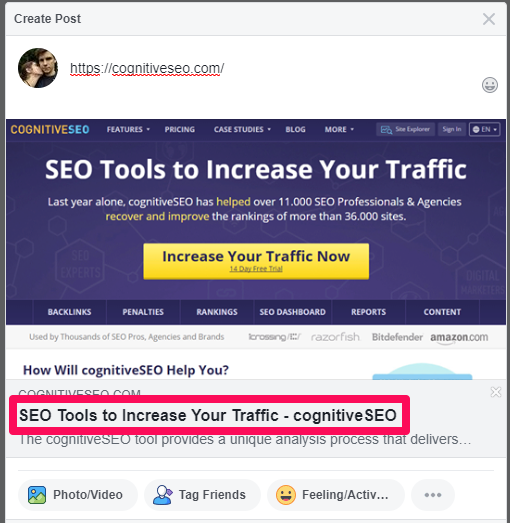
You might notice a slight difference between the Google title and the Facebook title. Truth is that the original title is actually the one in the Facebook post.
Our homepage’s title tag is actually “SEO Tools to Increase Your Traffic – cognitiveSEO” but on Google it’s “cognitiveSEO: SEO Tools to Increase Your Traffic”.
Why is it different in the Google search results? Well, it’s because sometimes, Google tends to rewrite titles. It’s not something we did on purpose. Google chose to do it.
The ‘brand first’ rewrite is one of the most common title rewrites. It usually happens only with the homepage. As you can see, the pricing page has the branding at the end of the title.
We’ll talk more about title rewrites towards the end of the article, so keep reading.
What’s the Difference Between H1 Tags and Title Tags?
Although they seem very similar and do share some similarities, there is a pretty big difference between the title tag and the H1 tag.
They are completely different HTML tags (<title></title> vs <h1></h1>) and serve different purposes.
The big main difference between the Title Tag and the H1 Tag is that the Title Tag does not show on the web page itself.
The Title Tag’s main purpose is to show on search engines and external websites that make a reference to your web page’s title.
On the other side, the H1 shows on the webpage or within the website itself.
This isn’t always the case and it depends on the CMS you’re using. However, most Content Management Systems out there tend to use the H1 tag as the on-page title.
Most of the time, the Title Tag and the H1 Tag are identical. For example, in WordPress, when you create a new blog post and write the title, you’re actually writing the H1 Tag. WordPress then pulls that information and also adds it to the Title Tag.
However, if you use an SEO plugin such as Yoast SEO, you can specify a custom SEO Title Tag which will be different from the H1.
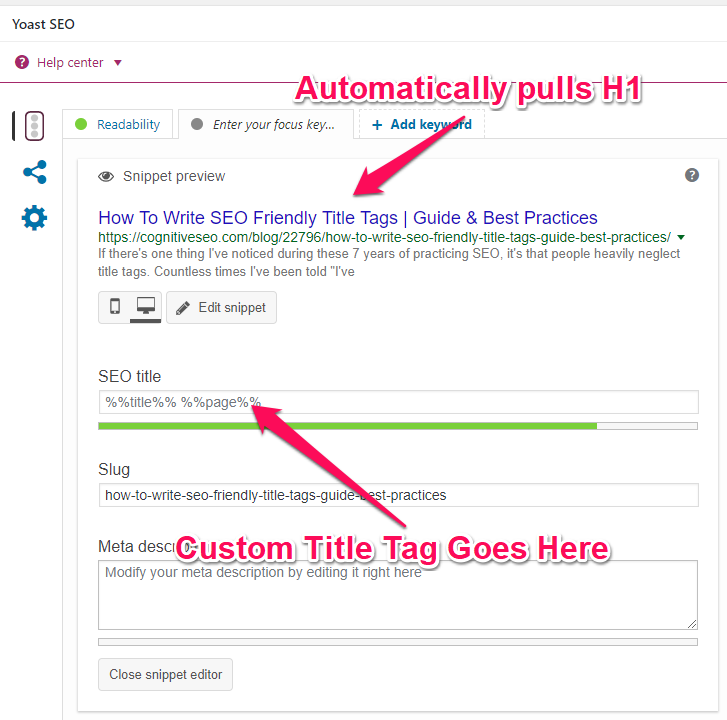
This means you can show something on your website but something different in the search engines. This is useful as you can add multiple keywords into your H1 tag when the Title Tag is too long and doesn’t fit.
Here’s one example of a longer H1 tag:
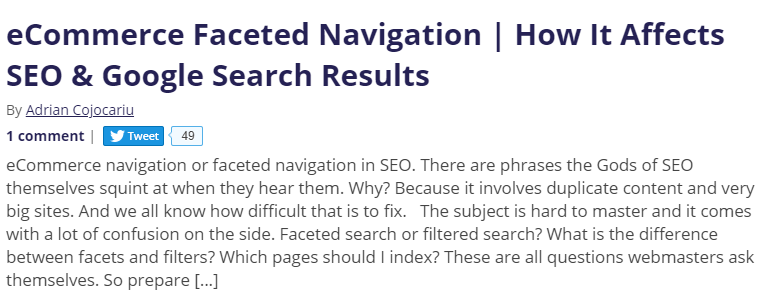
And the shorter Title Tag accompanying it, that fits the SERPs:

Another big difference is that there can be multiple H1s on a web page, although we recommend using H2 and H3 tags for multiple subtitles and sticking with a single H1 tag.
For example, on the blog page, WordPress automatically converts all the blog posts H1s to H2s, as the H1 of the blog page is “The SEO Blog from cognitiveSEO”.
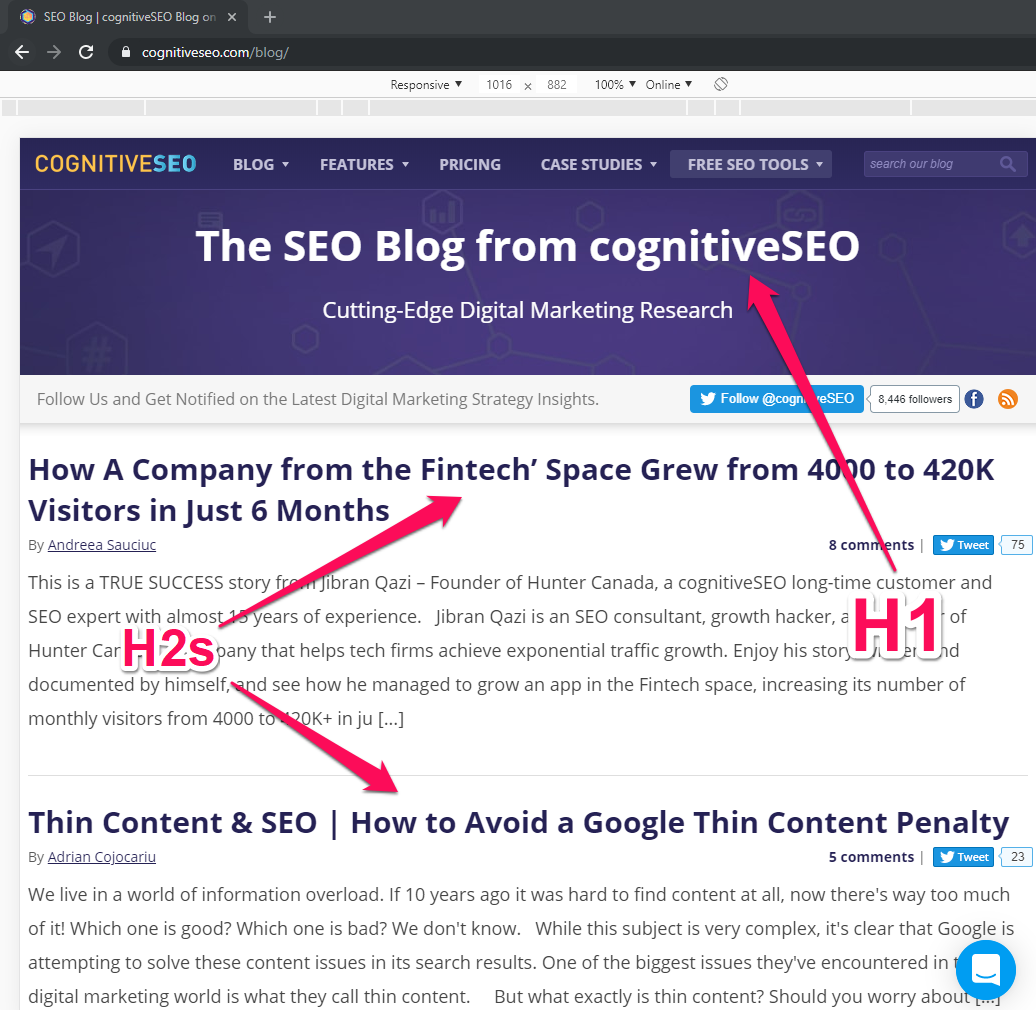
On the other side, it’s crucial that your website have only one title tag per page. Multiple title tags can negatively impact your rankings, so make sure you don’t do that.
SEO Title Tags Tips & Best Practices
Before we talk about actually crafting your SEO titles, we have to make sure you’re following the best practices.
Here’s a list of things that you should try to constantly keep in mind when you’re writing your titles. Once you know these, writing an SEO friendly title meta tag should be pretty easy!
Write the title for humans first
I’m writing this first because it’s very important. Sure, the titles are read by robots and algorithms and they’re the ones that rank your site.
However, when they finally make it to the top, titles are read by humans, who eventually dictate if they will click on it or not! If they don’t click on it, the algorithms will know your title isn’t a great one.
Try to avoid keyword stuffing and instead focus on being relevant.
User intent is also an important factor. What are your customers looking for? Are you writing your title for a commercial keyword or for an informational one?
Try to think what your target audience and customers would click on. You can always take a look at what your competition is doing. Don’t copy, but get inspired. The top positions are clearly doing at least something right.
Keep your titles short and to the point
When writing your title tag for SEO purposes, one of the first things you have to keep in mind is that the title has to be short.
Why?
If your title tags are too long, Google will make them shorter and will add […] at the end. This process is called truncation and it looks just like this:

This won’t directly impact your SEO but it can affect your CTR, which will eventually impact positions. Generally, you want to keep your title short enough to fit the Google search results.
How long can your title be? Generally, it’s a good idea to keep the title tag lengths between 60 to 70 characters. However, Google actually has a limit of 600 pixels in which it displays the title and, because different characters have different widths, the limit number might be different.
That’s why it’s a better idea to use tools such as the Yoast SEO plugin to make sure your title fits properly.
If you don’t use WordPress or another CMS and cannot install an SEO plugin on your web host, you can always use a tool such as MetaTags.io to quickly check if your title, URL and meta description are displaying properly in the search engine result pages.
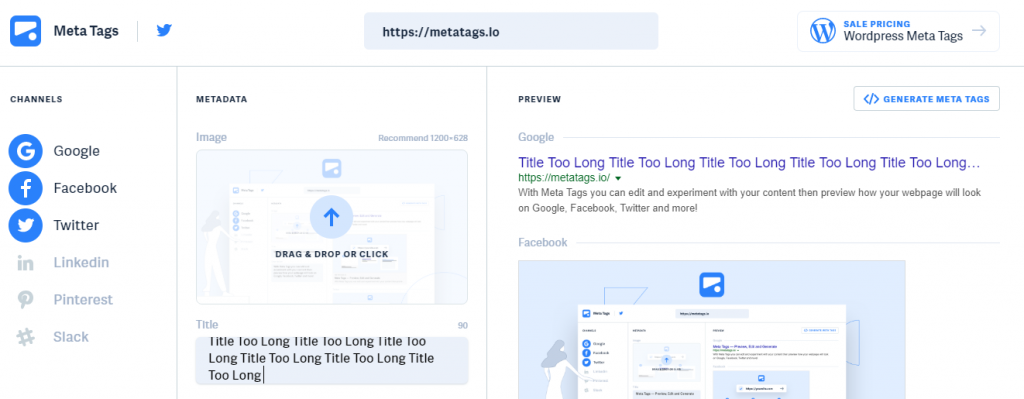
You can then manually add your titles and meta tags for SEO on your website, regardless of your platform or web host.
Keep in mind that it’s also a bad idea to keep your title too short. Too short titles might not grab the user’s attention either.
Quick tip: You can use | instead of – as a separator in your title sections. | has less pixels than – and in some situations it can help you get a fully displayed title, without having to remove any words.
Try adding the main keyword closer to the beginning
Google puts more weight on the keywords that are closer to the beginning. This also boosts the click through rate, as users click more on the results which contain the keywords they have just searched for.
Sometimes, you won’t be able to add the focus keyword with the most search volume right at the beginning.
For example, the primary keyword with the most search volume for this article is “title tags SEO”. However, that’s pretty hard to get inside a title and still make it sound good and natural.
Google is smart enough to figure out what an article is about, but you have to give it some good hints. If you give the right hints, it will figure it out easier and will reward you for it with better rankings.
So, writing “SEO Title Tags” instead of “Title Tags SEO” won’t be a big problem.
Quick Tip: If you also do Google Adwords, it’s a good idea to follow the best practices offered there. Google spends a lot of time perfecting CTR, so they definitely know what users want to click.
If possible, try optimizing the title for multiple keywords
Try to keep them in order. For example, this article is optimized for the following keywords:
“how to write seo friendly title tags”
“seo friendly title tags”
“seo title tags guide”
“seo title tags best practices”
If you look at the title of this article, you’ll see that you can find all these phrases in order, from left to right, although there might be some other words in-between.
The keywords must also align with what you have to say in the article. You shouldn’t include keywords just because they have a high search volume.
Optimizing one article for too many keywords is a bad idea. You might try to kill two birds with a stone. For example, if you write an article entitled “SEO Guide”, don’t expect it to rank for “keyword research”, “onpage optimization”, “link building”, etc.
Take advantage of the H1 Tag as well. If you can’t fit all the keywords you find relevant into the title, you can squeeze a couple more in the H1. Make sure you keep the focus keyword in the H1 as well.
Also, don’t forget the meta descriptions. You should add your keywords there as well, as Google tends to ignore your meta description if it doesn’t contain the keywords the user is searching for.
Try to avoid keyword cannibalization with other articles
You should take care of this before you even start writing your article. Check if your site doesn’t already have a page optimized for very similar keywords.
In other words, you need to have unique titles for your articles, each targeting a specific topic and set of keywords.
However, writing separate articles for each and every keyword is also a bad idea! You’ll end up with an issue called keyword cannibalization, when too many articles are competing for the same keywords.
For example, if I had two separate articles for “how to write seo title tags” and “seo title tags best practices” they would both compete for the keyword “seo title tags”.
Sure, you could still optimize them separately and they might even rank the way you want. However, if you start having more and more articles that target the same keywords, it might become harder and harder to rank with them.

So, since both of these keywords cover similar topics (regarding writing title tags for SEO) I’ve decided to try and optimize the article for both keywords.
However, for a completely different topic such as “Do Title Tags Affect SEO?” I would definitely write a completely separate article.
Cannibalization can also happen often when you publish a lot of content. When you’re writing 3 pieces a month for 2 years straight, you sometimes simply forget you’ve written about a topic before. I’ve done this mistake before.
That’s why we’re trying to cover as much of a topic as possible in a single article. Chances are that we won’t be writing something specifically for writing title tags again. We will only improve this article when the time comes.
However, that doesn’t mean you can’t add something about titles in another article. For example, you can have an H2 section about titles and how to write them in an SEO Optimization Guide. You can then use this content to improve your internal linking strategy.
Make your title catchy to improve CTR
The first thing potential readers see about your article when they search for a keyword on Google is your title tag. If that title tag doesn’t convince them to click, Google will observe that and consider it as a negative signal.
On the other hand, if more users click on your title, Google will see that as a positive signal and reward your website with better positions.
So, if your article is currently ranking #3 and out of 1,000 impressions, 18% of the clicks go to your article, 12% to the #2 spot and 25% to the #1 spot, you have a high change of switching seats with the #2 spot, to your benefit.
That’s why you have to make your title catchy. You can do this by adding emotion to your title or words that increase CTR such as “free”, “example” or even numbers (7, 21, 77 etc).
Here are a couple of examples:
5 Keyword Research Tips That Will Blow Your Mind
Best Free SEO Tools to Help You Improve Your Rankings in 2019
However, keywords have a higher priority, at least until you get your article to the top. Until you get to page 1, almost nobody except the search engines will see your article anyway.
Don’t bother testing the CTR by changing the title until you’re at least on page #1 of Google. Also, keep in mind that any modifications can impact your rankings negatively as well.
For example, if a no. 1 position increase on the main keyword resulted in 100 more visitors per month but the trade off in modifying your title would be to remove a set of keywords that could bring 200 visitors per month, then it’s not a good trade-off.
If your article is already ranking #1, you should’t make any changes until your competitors rank better than you.
Quick tip: You can use ▷ in front of your title to make it stand out from the crowd. You can also try adding emojis to your titles. where it makes sense. However, don’t turn your title into a clown (no offense intended to any clown SEO readers). Keep it civil.
Fill short titles with calls to action
If your main keyword is very short and you don’t have any secondary keywords that are relevant or make sense to add into your title, add a call to action or try to make it catchy.
For example, if your title is simply “Ski Rental Prices” and there are no other keywords that have search volume or make sense targeting, then you can add “50% Discount for 1st Time Clients” or “Best Prices in the Entire Resort”.
This way, you are taking advantage of the real estate instead of wasting it.
Make your article & title look fresh
Convince your potential readers that the article is relevant by adding the current year inside your article’s title. If you have a topic that keeps changing or evolving, it’s always a good idea to keep updating your articles.
However, once you update it, make sure you let your users know about this. Here are some examples from our blog:
Are Web Directories Still Relevant for SEO in 2019?
(This article was written a long time ago and updated this year).
21 Effective Low Effort & High Return SEO Techniques for 2019
(This article was written as new this year).
You can also add these keywords in the meta description if they don’t fit inside the title, although it’s better if they are in the title as well.
When you update articles, make sure you don’t also modify the URL. The URL should never be changed, if possible.
Back up your title tag with relevant content
The title is a very important ranking factor. However, there is a ranking factor more important than the title: the content itself!
That’s why it’s always a good idea to back up your title with relevant content. You can do this by adding relevant keywords in your content.
You can find these keywords easily by using the cognitiveSEO Keyword Tool & Content Assistant.
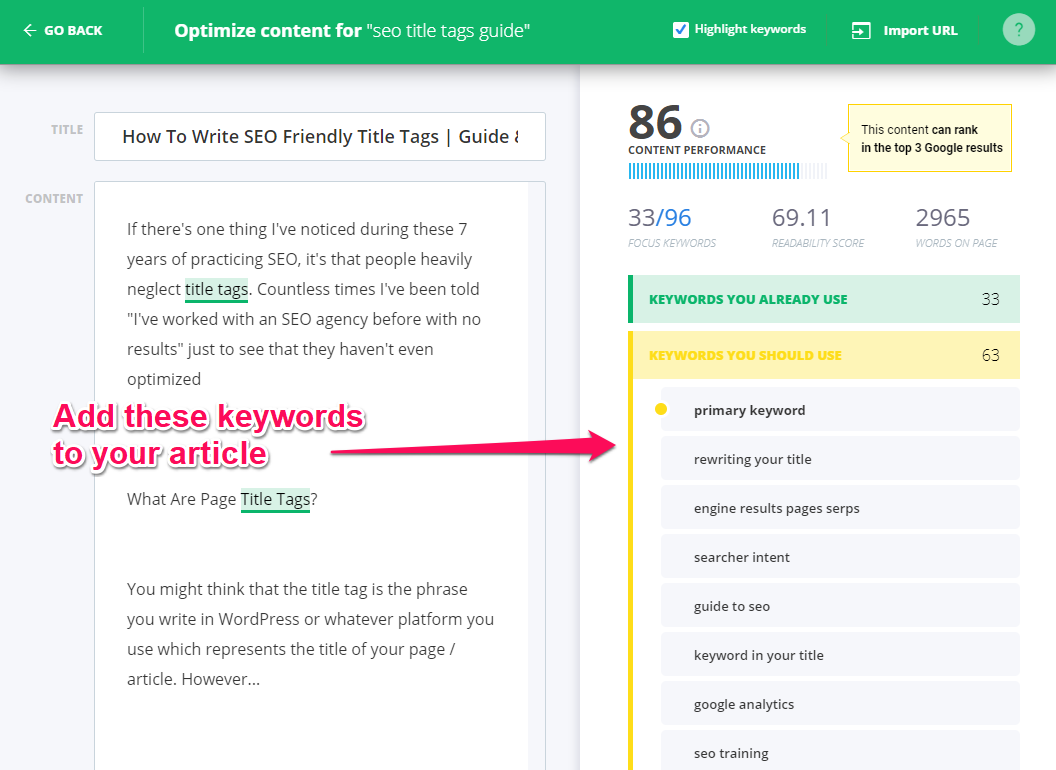
Also, make sure you avoid what SEOs call keyword stuffing. This occurs when a particular keyword or set of keywords is found too often inside an article.
Use different titles for SEO & Social Media
If you use social media to promote your content (and you should) you can always use different titles for different platforms.
By default, social media platforms take their titles from the title meta tag. However, you can use protocols such as Open Graph or Twitter Cards to set custom titles for your social media posts.
This can help boost your traffic and engagement, as you can stick with using keywords on your SEO title, while using something catchy and rich on emotion on your social media posts.
If you use WordPress, you can quickly do this via the Yoast SEO plugin. You can even specify a different description excerpt and image. This comes in handy in case the thumbnail image sizes on your website don’t match the ones on Facebook.
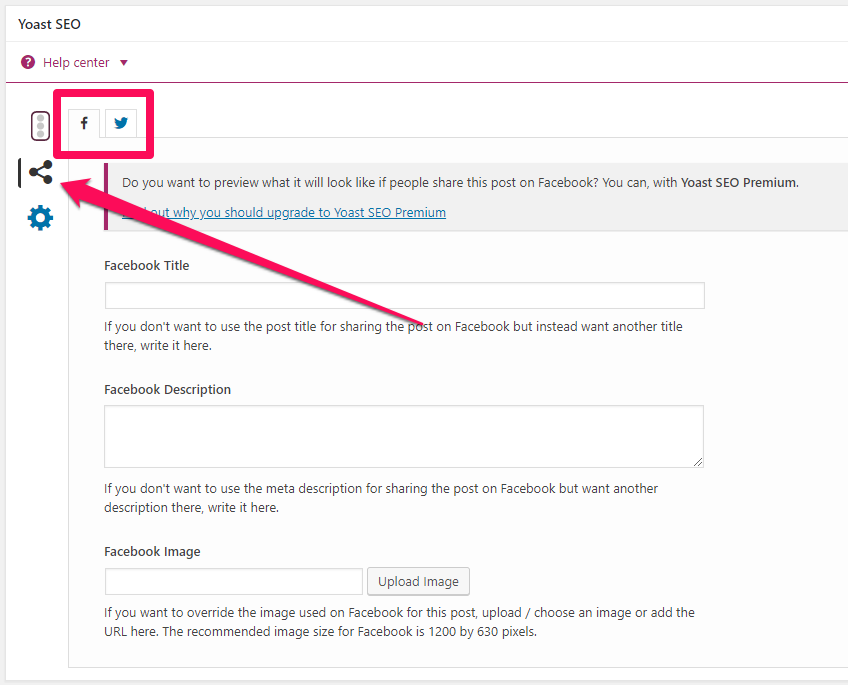
On a custom platform you can manually add the meta tags into the HTML:
OG example for title: <meta property=”og:title” content=” “/>. The title goes between the apostrophes under the content attribute. This title will show on Facebook instead of the title tag itself.
How to Craft an SEO Friendly Title Tag
Once you have the best practices in mind, you can start actually creating your title. However, step one doesn’t involve any writing!
Step 1: Choose your keywords wisely
Everything in SEO starts with keyword research. Without it, you’re venturing into the dark. You don’t know if the keywords have any search volume, you don’t know your competition and you don’t even know if your content is relevant.
Make sure you pick a primary keyword to target for your article. You can then pick a set of secondary & long tail keywords if they fit.
For example, in an article in Romanian which I worked on for a client, we decided to write about the primary keyword “weight loss exercises”.
However, you can always have secondary keywords, especially if you’ve decided to target more long tail phrases, with less traffic and competition.
The final title ended up begin “Best & Most Efficient Weight Loss Exercises You Can Do At Home”.
This title targets multiple keywords: “weight loss exercises”, “best weight loss exercises”, “efficient weight loss exercises”, “weight loss exercises at home”, “best weight loss exercises at home”, “efficient weight loss exercises at home”.
While this article is primarily optimized for “weight loss exercises”, it will gain traction a lot slower for this keyword as it is more competitive. Meanwhile, the other long tail phrases will bring traffic as the competition is lower and they will rank high easier.
Step 2: Draft your title tag
If you’re on WordPress, there is a dedicated field for the Title. By default, what you fill there will act as both the Title and the H1 tags.

You can use the Yoast SEO plugin as mentioned above to differentiate these two.
If you have a custom made website, ask your developer where the <title> meta tag is generated from and insert your title there.
Often times, new webmasters ask themselves if they should write the title before or after they write the article.
Well… Yes. You should write the title before the article, as well as improve it later on after the article has been written.
Writing the title first will help you outline the general idea of the article. However, the title ultimately represents the article, so until the article has been written the final title remains uncertain.
Step 3: Optimize the title tag
As you write your article/webpage, you might notice that there are new ideas that pop up in your head and new subtopics that you want to cover. Some of them might even be relevant enough to be included in the title as well.
That’s why you often have to rewrite your title tag to better fit your content. If the title tag is not relevant, it won’t be as effective.
Optimizing title tags isn’t always an easy task. If you want to include multiple keywords while still keeping the focus on the main one, things can get tricky.
Count in the best practice of making it catchy and you really don’t have enough space to write everything you want!
That’s why it’s a good idea to keep the SEO Title for SEO and take advantage of Open Graph and Twitter Cards to optimize your titles for social media as well.
However, one rule to keep in mind here is to try and keep things simple. Overly complicated titles might do more harm than good.
After you publish the article, you have to keep an eye on how the title is performing. We all know that SEO takes time. At first, it won’t be ranking very high.
Monitor your article with Google Analytics and the Google Search Console to see how it performs. Once it gets to page #1 or the search results, take a look at the click through rate.
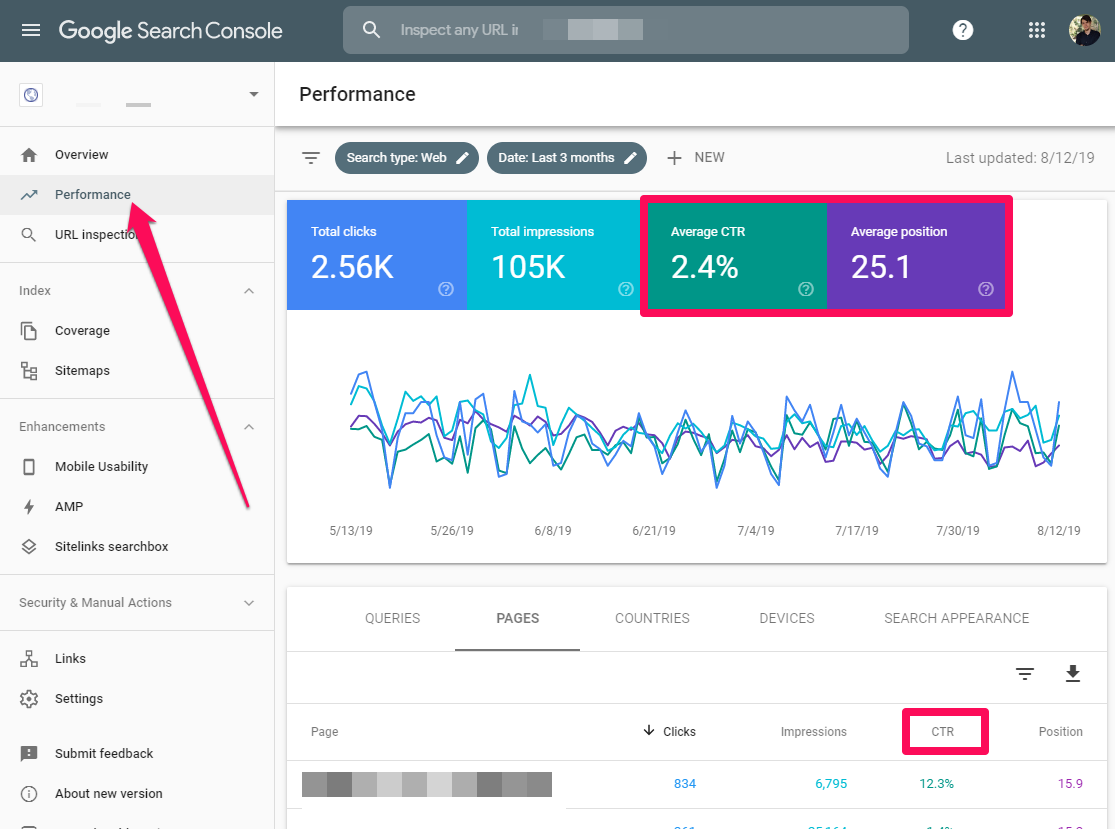
If the article starts stagnating on the 5th or 4th spot, you can try to play with the titles & meta descriptions to improve your CTR. This will result in higher rankings if you do things well.
Keep in mind that this can also negatively impact your rankings. For example, in an attempt to gain more clicks, you remove a long tail keyword from your title which will most probably result in a drop in rankings for that query.
However, it might be a good trade-off if your CTR for the primary keyword increases and brings in more visitors than the other long tail keyword would have brought.
How to Write Bulk (Auto-generated) Title Tags for eCommerce Websites
So now you know how to write an SEO friendly title tag for each and every page or article on your website.
But Adrian, what if I have thousands and thousands of pages and can’t afford to write titles for each and every one of them?
That’s a good question! Often times, you can’t afford to write a title for each and every post on your website. It simply takes too much time and it isn’t practical.
In this case, you have to dynamically set up your titles. This is usually done using the CMS. If you’re on WordPress, the Yoast SEO plugin can definitely help you. Just go to the Search Appearance Settings and you can set up templates for content types:
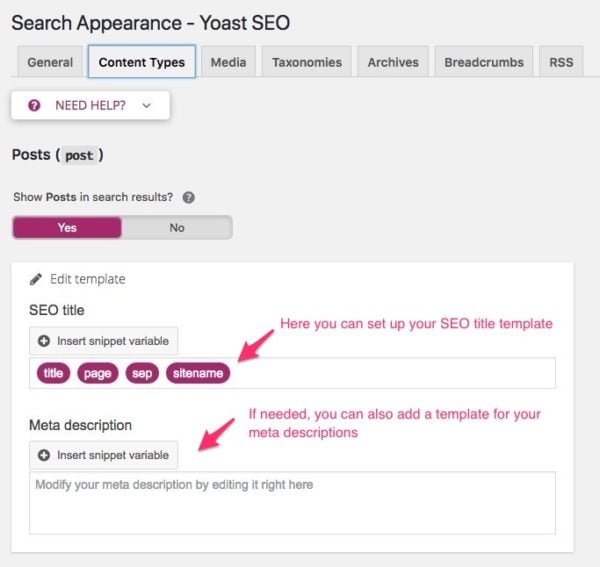
You can also have a template for your meta description and even set up custom variables to make the titles exactly the way you want. Maybe you want to add size or weight into your titles automatically because that’s what your users seek on your products.
Other platforms might have similar plugins. Just search the web for them. Magento, for example, already does this out of the box, as it is a platform specifically designed for eCommerce and hosting a ton of products and categories.
If you’re on a custom platform, then the variables must probably be set up into the database and called in the title tag dynamically using PHP. If you don’t know how to do that, then you should get in touch with your developer.
Here are some examples of good title structures for eCommerce sites or websites where manually writing each title isn’t an option:
- Product Name | Your Brand
- Product Name | Category | Your Brand
- Product Name | Call to Action | Your Brand
- Service | Location | Your Brand
This way you can generate some templates that will automatically write titles for your products and category pages.
However, for those important pages you should spend some extra time doing the proper keyword research, analyzing the competition and crafting unique titles and descriptions.
If you really want to see results, the best shot is to seek out those pages with good results and traffic and to properly optimize them. This includes writing unique titles for them.
You can find those pages in your Search Console or in Google Analytics. You can also determine those pages from keyword research.
Why Is Google Showing A Different/Wrong Title Tag For My Site?
The one true answer here is because it can. However, there are multiple reasons why Google might choose a different title for your site.
The first one is obviously that your titles are simply bad. If the title of your Homepage is Homepage, then you’d probably be grateful rather than concerned anyway.
Google wants to show the most relevant title possible for the user. Here’s a quick example of how Google does that.
If I search for “do meta descriptions affect seo” this is the title we get from the SERPs:

If we also add the brand to the query, “do meta descriptions affect seo cognitiveseo”, Google modifies the title tag.
This is Google trying to prove to the user that the results it is showing are the most relevant ones. They include the brand the user was searching for.
Another example was mentioned before, where the brand name inside a title was moved from the end of the title to the front for a branded search.
In these cases the keyword was in the title already. However, Google might get the required keywords from the content itself, be it from general paragraphs or headings.
This “rewriting” also happens with the meta descriptions. In fact, the very article I’ve mentioned above has a different meta description.
The original meta description is “This description might influence whether you visit our site or not. So, do meta description tags affect SEO? If you haven’t figured it out yet, click here.”
However, Google chose to show the direct answer to the question. Unfortunately, this isn’t in our best interest, as answering that question directly might result in users not clicking through to reach our website!
It is however in Google’s best interest, as the more time users spend on Google, the more ads they see and the more money Google makes.
Secondly, your titles might be taken from anchor texts of both internal and external links pointing to your pages.
This usually happens when your pages are blocked from being crawled and indexed.
Not being able to reach your page and read its title, if Google finds a URL pointing to your page on another website, it can still index it. If that URL is under an anchor text, that anchor text can be considered as a title for the page.
This case is extreme and if you’re blocking pages from being indexed, you have greater concerns than title rewrites.
Last but not least, it is possible that the Google Cache is simply outdated. If you have recently changed your title, it might take some time until Google recrawls your page and sees the modification.
You can try to rush this action from the Google Search Console by searching for the URL and hitting the Request Indexing button:

Can you stop Google from rewriting your titles?
Well… yes. By rewriting them the way it wants. However, as long as you follow the best practices and include the right keywords in your titles, you shouldn’t worry about it. It’s not such a big deal if Google partially rewrites your titles in some cases, especially if you’re ranking high!
Conclusion
Title tags are one of the most important SEO ranking factors out there. In order to have great SEO results you must make sure your titles are properly optimized. They have to target the right keywords and also intrigue the reader enough to click your result.
Writing them isn’t difficult if you follow a set of best practices, and the results they bring can be significant!
How do you write your SEO titles? Do you use any tools? How do you deal with bulk titles and descriptions? Let us know in the comments section below!
The post How to Write SEO Friendly Title Tags | Guide & Best Practices appeared first on SEO Blog | cognitiveSEO Blog on SEO Tactics & Strategies.
How to Write SEO Friendly Title Tags | Guide & Best Practices posted first on http://nickpontemarketing.tumblr.com/
No comments:
Post a Comment